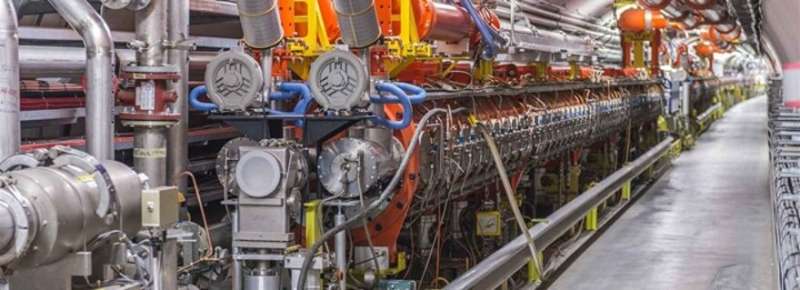Go ahead for dark matter experiment

Neutrinos are the shyest elementary particles known to exist. At this moment billions of them are shooting through each square centimeter of your body.
Leiden astroparticle physicist Alexey Boyarsky hopes to generate neutrinos in these elementary particles in massive numbers, in order to detect them and investigate their properties. This may even make it possible to discover the even more reclusive sterile neutrino, a (hypothetical) candidate particle for the mysterious dark matter.
This is the invisible form of gravitating matter that makes galaxies much heavier than can be accounted for by only the visible matter such as stars.
Hidden Particles
The idea is to use SPS, the startup accelerator that speeds up particles for the Large Hadron Collider (LHC), the underground, 27 kilometer wide ring accelerator near Geneva. Normally, SPS is only the first stage. After being ramped up in SPS, part of these accelerated particles are transfered to the LHC accelerator to be boosted further to extremely high energies.
Boyarsky: "But most of the SPS's particles aren't used at all. These could be funneled into SHiP." SHiP, which stands for "Search for Hidden Particles," is a giant neutrino detector that could be built in the course of this decennium.
"LHC is optimized for pushing the energy frontier, but we want to push the intensity frontier," says Boyarsky. The intensity is the number of particles generated per second. The more particles, the more collisions occur, the more collisions, the more neutrinos are generated, and the more neutrinos, the higher the chances that one of these neutrinos can be detected.
Three flavors
SHiP would cost around 200 million euros, and its design and funding are still being investigated. On 17 March however, CERN approved the building of a precursor detector called SND@LHC, which stands for Scattering and Neutrino Detector at LHC.
"This is very good news," says Boyarsky, "SND@LHC is a pathfinder experiment, in order to research different parts of SHiP." SND@LHC will use LHC collisions as a neutrino source, and will cost around 1 percent of SHiP. It can be built in an unused tunnel at 480 m distance from the LHC, where it can already investigate neutrino physics.
Neutrinos come in three flavors: electron, muon and tau neutrino's, with increasing but very tiny masses (which have not been measured yet). Neutrinos also mysteriously oscillate, which means that the different flavors can transform into each other.
Boyarsky: "LHC produces neutrinos with a range of energies. The physics tells us that the higher the energy, the larger the chance to detect the neutrino."
SND@LHC could even have a sporting chance to spot the sterile neutrino, if it exists. Boyarsky: "We might already access completely new physics."
Provided by Leiden University




















